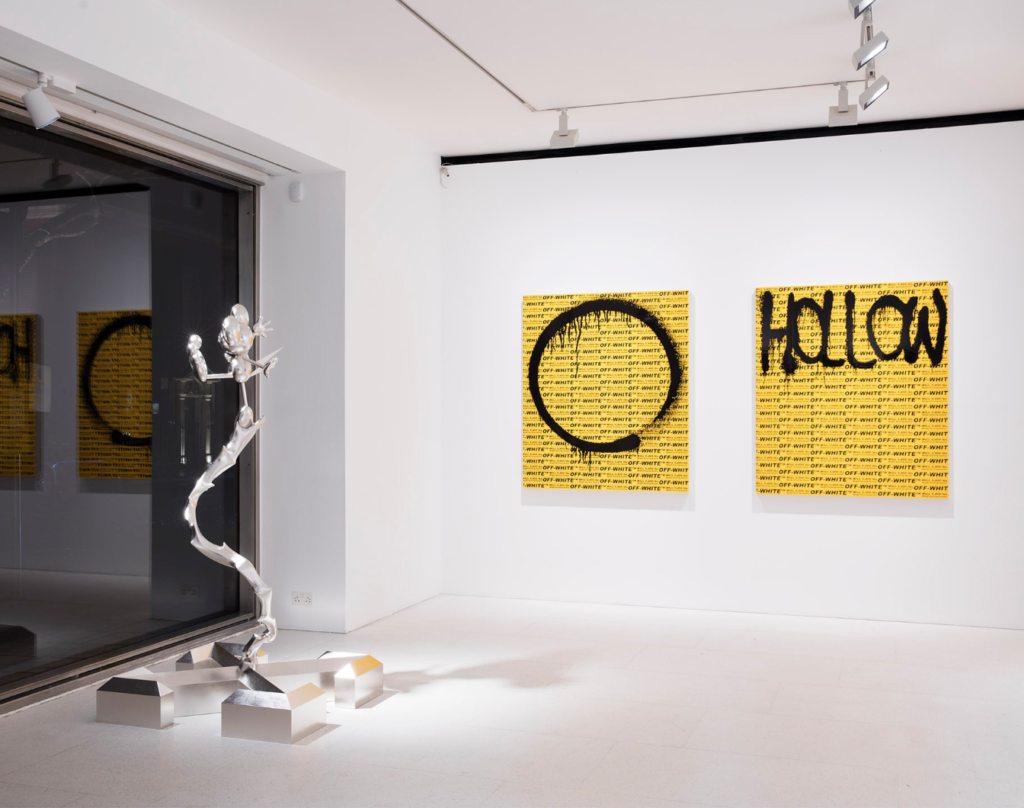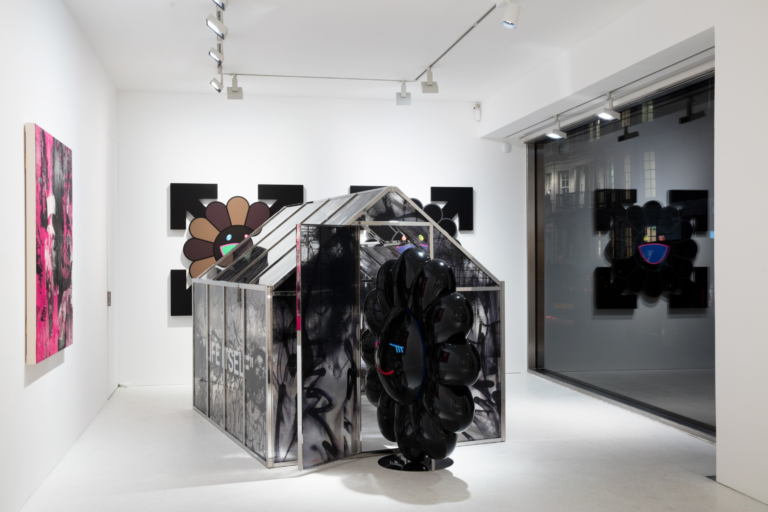Following their artistic collaboration in London, Takashi Murakami and Virgil Abloh, the recently appointed Louis Vuitton menswear designer, spoke with Derek Blasberg about how they met, their admiration for one another, and the power of collaboration to educate and impassion new audiences.
Derek Blasberg: Takashi and Virgil, when did you two guys first meet?
Takashi Murakami: It was about ten years ago and I just remember your shape. You were the biggest guy in Kanye [West]’s group! But you were also kind of quiet.
Virgil Abloh: [Laughs] That sounds like me. Kanye was doing an album cover for Graduation and it was one of the first trips I had taken with him as, basically, one of his assistants. We were working on the cover, coming up with ideas on the rollout, and technically we met for the first time then, even though I was sort of in the background trying to make projects come out on time.
How did the idea of this collaboration come to pass?
Murakami: I reached out to Virgil, probably on Instagram. A few years ago I noticed all these K-pop bands—friends of mine—wearing Off-White, and I was like, “What is that?” I then met Virgil in Chicago when I was working on my show [at the Museum of Contemporary Art] there. Soon after, I had the chance to do a panel talk with him at ComplexCon and I saw that he had a good understanding of contemporary art.
That’s where you’re from, right, Virgil?
Abloh: Exactly. In 2019 I’ll have a show at the Museum of Contemporary Art from my own career’s worth of work. So I saw on Instagram that they were installing Takashi’s show—we have the same curator, Michael Darling—and I was like, “Hey, can I come by and see what you’re working on?” They walked me through the exhibit, which started me thinking. When you see an artist’s work, you start drawing parallels, and that started a conversation.

Installation view, Murakami & Abloh: future history. Photo: Lucy Dawkins. Artwork ©︎Virgil Abloh ©︎Takashi Murakami
I remember when Takashi’s show opened, in June of 2017. So that’s when this started happening.
Abloh: Exactly. A lot of it is, if you put magnetic creative types in a room, something comes out of it. I think that’s why we have a lot of ideas and not much fear.
I know you’ve both collaborated with several brands, artists, designers, and so forth in the past. I guess my question for Takashi, who I see is wearing Vuitton pants, is, “How is collaborating with Virgil similar to and dissimilar from the projects you’ve done in the past?”
Murakami: When I was collaborating with Marc Jacobs it was still the early days of e-mail. We were communicating that way, and then people would go on vacation in the summer and we would lose contact for like twenty days. My studio and I were like, “What are we going to do?” We were worried about it. But with Virgil, of course, he’s a very modern, contemporary kind of guy, so he’s using everything from Instagram to WhatsApp for any message he has to communicate and shuffling it to all of the people around him. It took all I had just to keep up with the quota of information. Which was very much fun!
Abloh: That’s another interesting touch point in our narrative. One of my most impactful fashion purchases of all time was when Marc Jacobs decided to collaborate with Murakami. In Chicago, you know, like me and Kanye, we were in love with rap music, obviously, we love luxurious things, we love art, but we would never go to a museum in an afternoon. We did go, though, to Louis Vuitton, which ironically was only a block away from the Museum of Contemporary Art, and it inspired us to check this guy out. The new collaboration was in the Louis Vuitton store, and I bought a white pouch with the multicolored monogram, which I still have—I can show it to you. It introduced me to Murakami. I first saw his work in the store, so in a way I’m a product.
I’m sure the Vuitton collaboration was a way lots of new people encountered his work.
Abloh: Imagine, when you release stuff, it educates somebody. You don’t even intend to. So that’s an ironic thing: I first interacted with the work through a Louis Vuitton bag.
Virgil, I’m going to ask you a similar question: after collaborating with so many other people, including Kanye, how was working with Takashi?
Abloh: More than anything, what I’ve learned up to this point is that Earth at any given time is populated by a certain number of hypercreatives, people who are on the planet solely to think and drive and output ideas. Like Kanye or Karl Lagerfeld, who exist for that sole reason, Takashi can think and process in a way that is not work. They exist to create, and it’s effortless. I mean, yesterday was the first day we’ve both been tired [laughter].
Murakami: I was happy to see Virgil tired—then I knew he was human!
Left: Takashi Murakami and Virgil Abloh, Glance past the future, 2018, acrylic on canvas mounted on aluminum frame, 55 ½ × 47 ¼ inches (141 × 120 cm) ©Virgil Abloh ©Takashi Murakami. Right: Takashi Murakami and Virgil Abloh, TIMES NATURE, 2018, acrylic on canvas mounted on board, 59 ⅛ × 59 ⅛ × 2 inches (150 × 150 × 5 cm) ©Virgil Abloh ©︎Takashi Murakami.
Let’s talk about the work. How did you decide on the actual artworks that are going to be displayed today?
Abloh: We let our imagination run. We didn’t think of genres, which I think is the strength of this show. It’s two people who obviously have their own practice, but in our conversation there was no limit. Usually it’s the other way: a fashion designer works with an artist to make a print that makes a garment. But we went limitless: Let’s make serious art objects that represent these same ideas, that don’t mask themselves in ways that have existed before. For me it was like, Let’s make a good sculpture, let’s make large work, let’s make serious paintings, let’s make small things, let’s share DNA and put it on a timeline of 2018 contemporary art, and let’s see what happens.
That’s a good way to put it: let’s share the DNA of the art.
Abloh: We’ve seen fashion evolve because it looks and feels different. I went to Balenciaga yesterday and there was a line outside. That means, culturally, there’s something exciting happening. It’s been the same name on the store since Cristóbal Balenciaga was alive, half a century ago. That’s exciting to me. There’s a way to design clothing that makes it more intriguing.
It’s London Fashion Week and I’ve been to a bunch of fashion shows, but the feeling is that people are more excited about an interesting collaboration and an art exhibit than just another show. Why do you think these sorts of collaboration are more important or more influential now than a traditional runway show?
Abloh: Everything that brought us to the industry we understand. You constantly have to reexcite your audience, you know? If they believe in you, they believe in you, but now it’s like, “Show me something new.” So you have to challenge yourself to progress to make something new. And collaboration is a modern way of working. If you look behind every one of Takashi’s paintings, the name of every person who contributed to it is written on the back. I’m the same way—it’s my studio, my team, it’s like this is an opportunity for a collective. I think our work is, “Hey, we collaborate!” Because we collaborate behind the scenes every day. It’s not like the designer stitches everything and packs it in a box and drops it off at FedEx and keeps the receipt. Takashi’s making art in the same way.
Takashi, I think a lot of contemporary artists have been fearful of playing with fashion, of entering a world of expression not considered traditional art. You’ve never been afraid of that. Why do you think you’ve been so fearless with the way you create?
Murakami: I’m an outsider, I’m Japanese, I don’t feel obliged to play by the rules. Which isn’t to say I don’t know them. When I see Western contemporary artists who are considered very serious, I can be jealous, because they don’t have to explain their art.
The other reason I’m happy to play in other mediums is the reason in Virgil’s story about Louis Vuitton. There’s an audience in art, but in fashion there’s another set of eyes. They found my collaboration and looked up what else I was creating.
“It doesn’t matter what SELLS. What matters is that it EXISTS.”

Installation view, Murakami & Abloh: future history, Gagosian, Davies Street, London, February 21–April 7, 2018. Photo: Lucy Dawkins. Artwork ©︎ Virgil Abloh ©︎ Takashi Murakami
“It doesn’t matter what SELLS. What matters is that it EXISTS.”

Installation view, Murakami & Abloh: future history, Gagosian, Davies Street, London, February 21–April 7, 2018. Photo: Lucy Dawkins. Artwork ©︎ Virgil Abloh ©︎ Takashi Murakami
You once told me you have Instagram to thank for this collaboration.
Murakami: It’s true!
Abloh: It’s like a high school reunion for everyone!
How do you anticipate that the creations you two have done together will integrate themselves into the art world?
Murakami: That’s a very good question. We have great supporters in young kids. Young kids, like sneaker heads, they’ve already bought something from him and something from me, maybe a toy or a gadget. At the same time, they’re interested to see how this comes into contemporary art. These guys have fast desires. They want to buy something and keep it in their collection.
Abloh: There’s obviously an evolution of education. It all starts with what you know, right? If you know that’s a Royer couch you’re sitting on, all of a sudden you’re comparing Royer to Restoration Hardware. In a large sense, the biggest education device in art is fashion—fashionable things. Style. Now that sort of epiphany, it’s one of those blurry lines that lends a space for people to create. I think we both see this huge explosion on a highway that no one’s playing in. Everyone’s still in the same lane. The kids standing at Supreme, or wearing the latest fashion trend: imagine how much they’ve invested in their apartment, or specifically how much they’ve spent in their closet, cost per square inch. They could probably afford this painting!
My thought was, “It doesn’t matter what sells. What matters is that it exists.” Once you’re awake in that space, in that fever for the latest trend of shoes or sneakers, once someone makes something for a wall, or for the rest of your environment, that will enlighten your lifestyle. That’s how the right couch can make your whole existence. You can literally only wear so many clothes at one time. That’s where I think it’s inspiring to me: the kids that are in our legions, in our communities, are going to see something in a different medium than typically expected.
